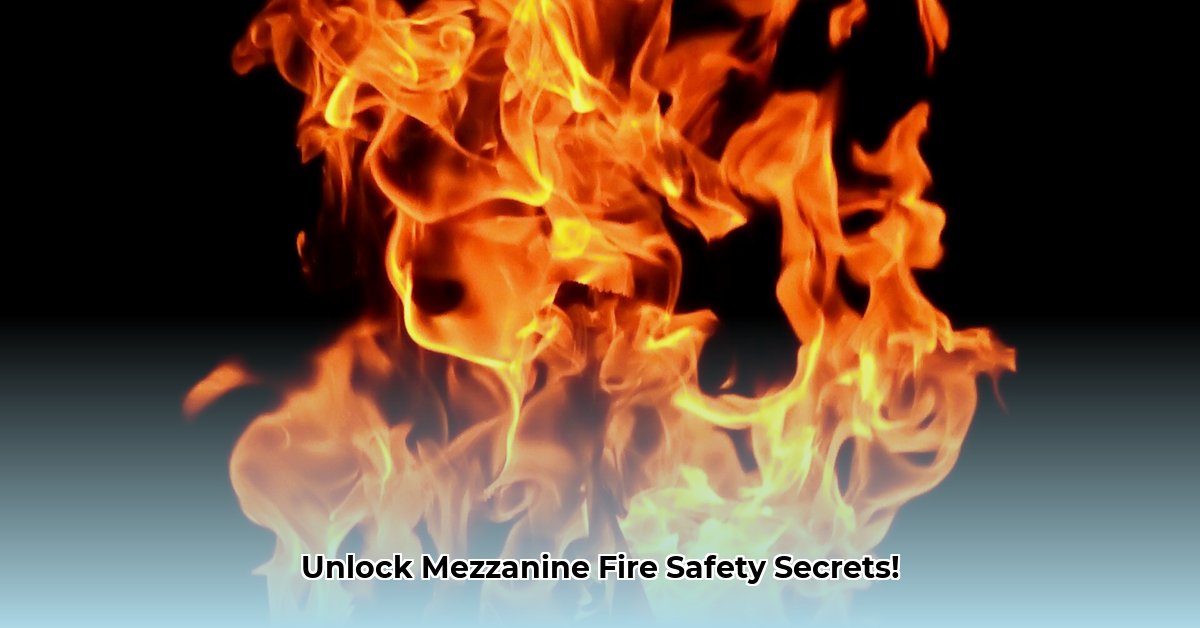Got a mezzanine floor? Great for extra space, but it also means extra fire safety rules. Ignoring them could lead to serious problems – accidents, huge fines, and potential legal ramifications. This guide shows you what you need to know to keep your mezzanine safe, code-compliant, and legal. We’ll explain the rules in plain English, step-by-step, so you can easily create a solid fire safety plan, covering building strength, material selection, and safe exits during a fire. For more detailed information on safety regulations, see this helpful guide on mezzanine safety requirements. Let’s ensure your mezzanine is both functional and safe.
Fire Safety Codes for Mezzanine Floors: A Comprehensive Guide
Mezzanine floors add valuable extra space to warehouses, retail stores, and offices, but they also introduce fire safety concerns. This comprehensive guide breaks down the critical regulations concerning mezzanine fire protection requirements to guarantee your mezzanine adheres to the strictest safety standards. Prioritize protecting lives and property by going beyond simply following the base legal requirements.
Understanding the Basics: Navigating Codes and Standards
Think of mezzanine fire safety as a multi-layered system, composed of standards from the International Building Code (IBC), Occupational Safety and Health Administration (OSHA), and potentially, state and local fire codes. These codes work together to provide a safe and compliant structure. The IBC sets the minimum standards for escape routes, fire-resistance rated construction, and structural considerations. OSHA focuses on protecting workers on the mezzanine with requirements for guardrails, safety gates, and proper safety training. Adhering to all applicable codes ensures safety, prevents fines, and mitigates potentially costly legal issues. Stay informed about the latest updates to these codes and how they might affect your mezzanine’s safety.
Decoding the International Building Code (IBC) – Establishing a Foundation for Safety
The IBC provides the bedrock for mezzanine fire safety by defining limitations on overall size (typically restricting it to no more than one-third of the floor’s area), mandating clearly defined and accessible escape routes, and establishing egress requirements crucial for safe and rapid evacuation. The IBC also dictates that there must be sufficient headroom both above and below the mezzanine floor (generally a minimum of 7 feet). Ignoring these critical elements can lead to significant legal and safety problems. These requirements have a direct impact on mezzanine fire-resistance ratings and overall structural design.
OSHA: Prioritizing Worker Safety on Mezzanines
OSHA emphasizes worker safety in elevated workspaces, such as mezzanines, by setting forth rules designed to prevent falls and injuries. These regulations include precise specifications for guardrail height, the use of safety gates and nets, proper safety signage, and comprehensive worker training programs. These regulations work in tandem with the IBC requirements, fostering a comprehensive safety culture and a safe working environment. Ensure your design considers both sets of regulations to prioritize worker safety and prevent potentially devastating consequences. This integrated approach ensures comprehensive OSHA mezzanine safety compliance.
Key Elements for Mezzanine Fire Safety: Materials, Construction, and Fire Suppression
Designing a fire-safe mezzanine requires careful consideration of material selection. The IBC specifies fire resistance ratings for structural and finishing materials, based on the building’s occupancy type and use. Furthermore, proper sealing of any openings where pipes, ducts, or wires pass through floors or walls is crucial to prevent the spread of fire and smoke. It is always recommended to carefully review local fire department regulations, as specific requirements can vary significantly based on jurisdiction. These local regulations can add specificity to your design and affect the overall fire-rated mezzanine construction costs.
Practical Steps: A Safety Checklist
Let’s translate theory into action. Here’s a comprehensive plan to guarantee your mezzanine meets all applicable safety regulations:
- Comprehensive Hazard Assessment: Conduct a thorough assessment of your mezzanine to identify potential fire hazards, slip, trip, and fall hazards, and any other safety concerns.
- IBC Compliance Audit: Verify that your mezzanine’s dimensions, location, and escape routes fully comply with IBC Section 505.2 and other relevant sections.
- Fall Protection Implementation: Implement robust fall protection measures, including appropriately sized and installed guardrails, safety nets where applicable, adequate safety signage, and comprehensive employee training on fall prevention.
- Fire-Resistant Material Selection: Specify and use construction materials that possess the appropriate fire resistance ratings as determined by the IBC and local building codes.
- Establish a Regular Maintenance Schedule: Develop and implement a detailed plan for regular inspections, routine maintenance, and timely repairs.
- Comprehensive Training Program: Implement and maintain a comprehensive training program to ensure that all employees understand fire safety procedures, evacuation plans, and the proper use of fire safety equipment. Conduct regular refresher training.
The Critical Importance of Regular Checkups and Proactive Maintenance
Think of regular inspections and proactive maintenance as your essential safety insurance. Consistent checks, routine maintenance, and ongoing training are indispensable for maintaining a safe and code-compliant mezzanine. Neglecting these proactive steps can lead to costly repairs, fines, and potentially, tragic accidents. Proactive maintenance prevents minor problems from escalating into major emergencies. Studies show that approximately 75% of mezzanine-related incidents are preventable with diligent inspection and maintenance practices. Prioritize the implementation of regular inspections to keep risks to an absolute minimum.
Common Hazards and Mitigation Strategies
Here’s a detailed review of potential hazards associated with mezzanines and effective strategies for minimizing risks:
| Hazard | Likelihood | Severity | Mitigation Strategies |
|---|---|---|---|
| Falls from mezzanine | High | High | Install sturdy guardrails, maintain safety nets, provide personal fall arrest systems (PFAS) where necessary, require regular training for all personnel, ensure proper lighting. |
| Fire | Medium | High | Utilize fire-resistant materials, install and maintain automatic sprinkler systems, provide clearly marked and easily accessible emergency exits, conduct regular fire drills, maintain fire extinguishers. |
| Structural failure | Low | High | Conduct regular inspections by qualified structural engineers, ensure robust design and construction according to the latest IBC codes and standards, monitor load limits. |
| Falling objects | Medium | Medium | Install toeboards, use netting or screening, implement safe material handling procedures, provide designated storage areas, enforce the use of hard hats. |
| Inadequate Egress | Medium | High | Ensure sufficient exit paths that comply with code, clearly marked and illuminated exits, maintain unobstructed egress routes, conduct regular evacuation drills. |
Remember, complying with minimum code requirements is only the starting point. Exceeding those minimums demonstrates a commitment to safety and can further minimize risk. Prioritizing mezzanine fire safety not only ensures compliance with applicable laws and regulations but also fosters a safer workplace, protecting your most valuable assets: your employees. It represents a direct investment in employee well-being and long-term business longevity. Building codes and safety standards are subject to change, so staying informed about the latest updates and revisions is of paramount importance. What specific steps are you taking to remain updated on the most current safety revisions?
How to Ensure IBC and OSHA Compliance for Mezzanine Firestopping Pipe Penetrations
Key Takeaways:
- Mezzanine fire safety requires strict adherence to IBC and OSHA regulations, which encompass structural integrity, comprehensive fall protection measures, and stringent fire safety protocols.
- How to ensure IBC and OSHA compliance for mezzanine firestopping pipe penetrations necessitates careful planning, meticulous material selection, and precise execution during construction. Given that jurisdictional variations exist, it is critically important to conduct a thorough review of local codes and ordinances.
- The requirement for firestopping pipe penetrations in mezzanine floors can be ambiguous, creating a grey area that often requires professional guidance and interpretation.
- Regular inspections, proactive maintenance, and meticulously maintained documentation are crucial for ensuring long-term compliance and minimizing potential risks.
Understanding the Regulatory Landscape
Constructing a mezzanine involves navigating a complex landscape of regulations including the IBC, OSHA standards, and local fire codes. These regulations may overlap, potentially creating confusion and compliance challenges. The mezzanine design must rigorously adhere to all structural load requirements as defined by the IBC and meet all fall protection requirements mandated by OSHA. Successfully navigating these complex standards can have a significant influence on the overall mezzanine firestopping solutions costs.
Addressing Pipe Penetrations: A Critical Detail Often Overlooked
One often-overlooked aspect of mezzanine fire safety is how to ensure IBC and OSHA compliance for mezzanine firestopping pipe penetrations. While the IBC generally dictates fire resistance requirements for building elements, the specific requirements for firestopping pipe penetrations can be unclear or subject to interpretation. As a result, it’s generally recommended to seek expert advice from qualified fire protection engineers or code consultants. Jurisdictions often enforce regulations differently, so always verify specific requirements with your local Authority Having Jurisdiction (AHJ). Does your team have documented procedures that specifically address how to verify local requirements prior to beginning each project?
Step-by-Step Guide to Compliance
Here’s a detailed guide on navigating the complexities of pipe penetration firestopping:
- Consult with the AHJ: Contact your local AHJ early in the design process to clarify all specific requirements related to firestopping.
- Seek Engineering Expertise: Obtain a professional assessment from a licensed structural engineer or fire protection engineer.
- Select Approved Materials: Choose fire-rated materials and firestop systems that meet or exceed local standards.
- Ensure Proper Installation: Follow the manufacturer’s installation instructions precisely to ensure
- Backsplash For Gray Cabinets: Choosing the Right Backsplash Style - December 13, 2025
- Gray And White Backsplash: Ideas For Timeless Style - December 12, 2025
- Gray Kitchen Backsplash Ideas: Find Your Perfect Gray Tile - December 11, 2025









